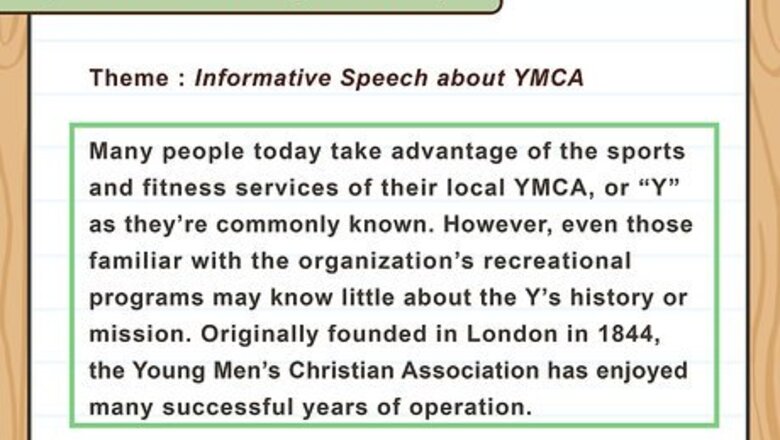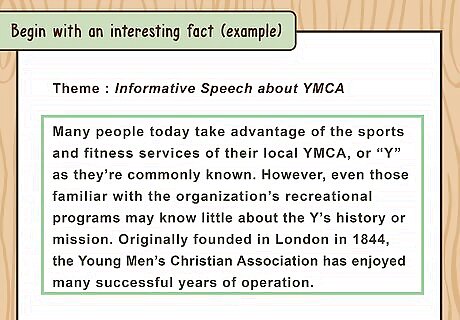
views
Brainstorming Ideas for the Keynote Speech
Determine the purpose of the speech. Ask yourself, “Why am I giving this speech?” “What am I trying to say by presenting this speech?” Often, the main purpose of a keynote speech is to reiterate or explore the theme of an event, program, or conference. You may also have knowledge about the theme that you can share in the keynote. If there is a theme of the event, you may use this as your purpose or inspiration for the speech. For example, if the theme of the event is “Social Responsibility,” the purpose of your speech may be to explore your experiences with social responsibility on a professional and personal level.
Identify the interests of your audience. Ask yourself, “Who am I speaking to?” “Who is my speech meant for?” Think about the age range of the audience as well as their background and level of expertise. Tailor the speech to suit the audience. For example, if your audience is within an age range of 20-30 and are social responsibility advocates, you may make the speech light, engaging, and full of specialized language that you know your audience will understand.
Come up with one to three key points for the speech. A good keynote speech will have at least one to two key points, or takeaways, that the audience can engage with. Write down one to three key points that expand on the main purpose of your speech. These could be one to three terms that you are going to discuss in detail, or one to three ideas. For example, if you are writing a speech around the theme of social responsibility, you may focus on three key points: the history of social responsibility, the current state of social responsibility, and where social responsibility is headed next.
Read examples of keynote speeches. To get a better sense of the style, tone, and language of a keynote speech, read good examples online. You can look at a list of the top keynote speeches online or search for keynote speeches presented on popular public speaking sites, like TedTalks. You can find the top keynote speeches of 2016 at https://www.bigspeak.com/best-keynote-speakers-of-2016.
Crafting the Keynote Speech
Start with an engaging story. One of the best ways to grab your audience’s attention is to tell a short, engaging story. Pull a story from your own experiences in the field. Look at current events for a story that relates to the purpose of your speech. Try to tell the story in bullet points, highlighting the key moments in a few sentences. For example, if you are writing a keynote speech on diversity in the classroom, you may tell a story about a student of color that you worked with in your classroom as a teacher. You may also look in the news for a story about a student of color who publicly spoke out about difficulties with diversity in the classroom, preferably a news story based in your area or country.

Begin with an interesting fact. Another option is to start with a fact you find interesting or engaging. Pick a fact that may not be known by a lot of people, or by the majority of your audience. You may use a fact from your own research or look for facts from trusted sources that relate to the purpose of your speech. For example, if the purpose of your speech is to discuss social responsibility in the corporate world, you may open with a fact about how consumers tend to buy more if a brand is socially responsible.
State the purpose of the speech. In the beginning of your speech, you should also state the purpose clearly and concisely. You may state the purpose right after your opening story or fact. State the purpose by saying, “I am here today to talk to you about…” or “Today, I am going to be sharing…”. For example, your purpose may appear as, “I am here today to talk to you about social responsibility, the theme of this conference and the theme of much of my professional work.”
Use humor to add levity. Humor can be a great tool in a keynote speech. Being funny can help to engage the audience and make your speech more memorable. Try to adopt a joking, light tone throughout the speech. Have a balance of funny asides and serious moments. For example, you may make a funny aside that is self-deprecating, such as, “I wasn’t always a great teacher. Sometimes, I was known as the fun teacher or the angry teacher. Not always the great one.”
Repeat key terms and words. Repetition can be a great way to reinforce your ideas and remind the audience of the key points in your speech. Return to several key terms in your speech so the audience stays engaged. Bring up a point made earlier in the speech so the audience is reminded of the purpose of your speech. For example, you may highlight terms like “unity,” “engagement,” and “social consciousness” in your speech by returning to them at least twice. You may begin the speech by mentioning these terms and then return to them again later in the speech.
Write the speech in your natural voice. Don’t try to put on a professional or formal tone, especially if it makes you feel awkward or uncomfortable. Try to express yourself like you would to a colleague or a friend. Use language that you use everyday and try to infuse the speech with your natural voice. You will come off more convincing and engaging this way. For example, you may use a funny saying that you use with your students in your classroom in the speech. Or you may use less formal words and terms to keep the tone of the speech conversational.
Wrap up the speech with a call to action. End the speech by compelling the audience to take some kind of action. The action could be to think about an idea they may not have considered before or to engage more with certain members of their community. Wrapping up with a call to action will give the audience a clear takeaway. For example, you may have a call to action that refers to the story or fact you used at the beginning of your speech: “Just like my student who reached out to a peer in need, I ask you all now to be vulnerable, to try to reach out to someone in your community who needs help.”
Polishing the Keynote Speech
Read the speech aloud. Once you have a draft of the speech completed, take the time to read the speech aloud to yourself and to others. Listen to how the speech flows. Notice if there are any awkward sentences or sections. Adjust them so the speech sounds natural and polished. When you read the speech aloud, notice if you skip over any words. You may be able to remove any words you skip over for flow. If you read the speech aloud to others, you can ask them for feedback. Ask them if they found any parts of the speech boring or hard to follow. Be open to getting constructive feedback on the speech so it is at its best.
Proofread the speech. Make sure the spelling, grammar, and punctuation in the speech is correct. Try reading the speech backwards to confirm each word is spelled correctly. Circle all the punctuation and confirm it is correct. Correct punctuation is especially important if you are going to read the speech aloud to an audience, as the punctuation will tell you when to pause or take a breath. Often, a comma means pausing in your speech and a period means taking a short breath.
Revise the speech for clarity and length. You should also look over the speech to make sure each section is clear and easy to follow. Often, shorter is better so if there are any wordy or overly long sections, try to make them shorter. Look for any words or terms you do not need. If there is a time constraint for the speech, you should also time yourself reading the speech to confirm it is within the limit.














Comments
0 comment